Tilia spp.
The classic aromatic allure of a linden tree in full bloom is usually enough to capture anyone’s attention. And even if you miss the timing of the elegant flowers, you’ll be romanced by the symbolic heart-shaped leaves.
Linden trees offer a harmonious blend of timeless grace and utilitarian strength.
From my perspective as a permaculture and food forest enthusiast, lindens are a dream thanks to their plethora of uses.

We link to vendors to help you find relevant products. If you buy from one of our links, we may earn a commission.
As we explore the world of lindens, I invite you to embrace the qualities that make them a beloved choice for gardeners and nature enthusiasts alike – from their rich cultural history to their generous offerings of flowers and foliage.
Whether you’re drawn to their aesthetic appeal or their practical benefits, this guide is crafted to enrich your understanding of, and assist you in nurturing, these arboreal treasures.
Here’s a look at what I’ll cover:
What You’ll Learn
Lindens occupy a sacred space in my heart and in my landscape. I hope they’ll win space in yours too. Ready to learn more about what makes them special? Let’s go!
What Are Linden Trees?
Lindens are the only tall tree members of the Malvaceae, or mallow, family of plants. This family also includes garden favorites like hollyhocks and rose of Sharon.
These trees belong to the Tilia genus, which contains about 30 species. They are deciduous shade trees found growing wild in forests and gracing gardens in both urban and rural settings in the United States, Canada, Europe, and Asia.
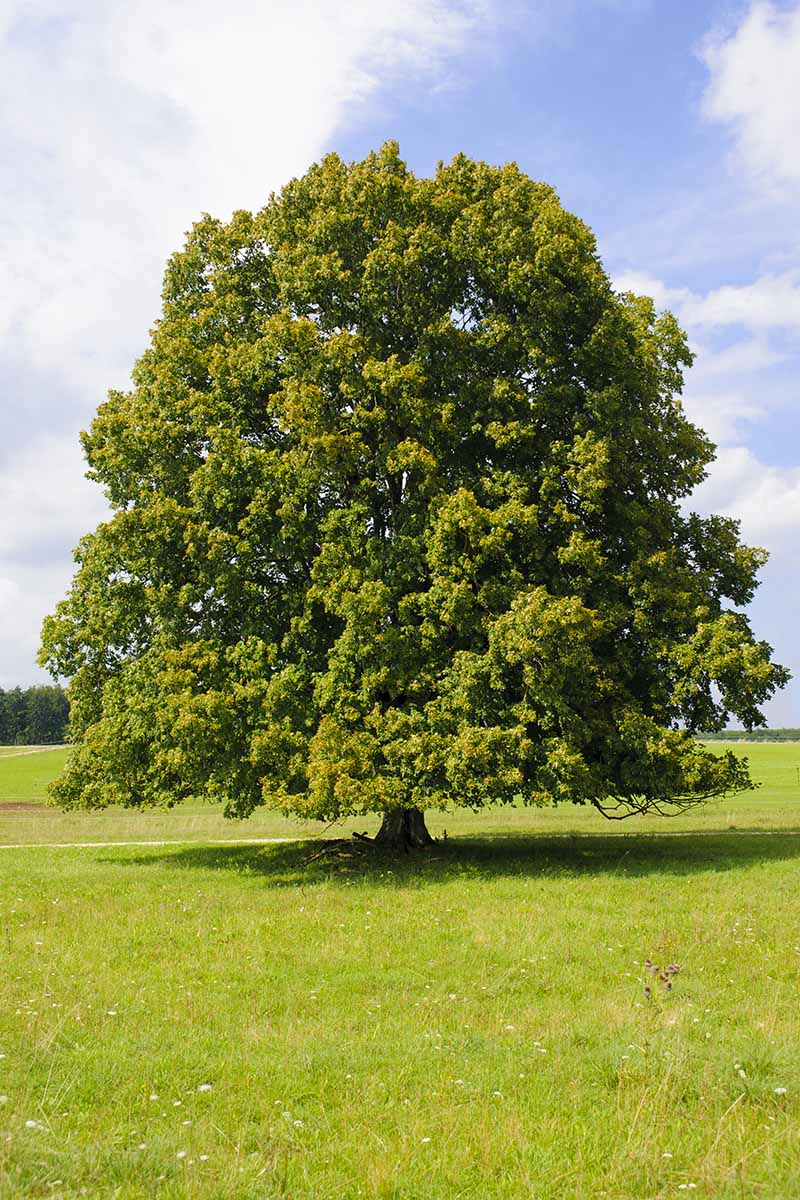
Commonly called linden, in North America these trees are often referred to as basswood, particularly the American basswood, T. americana.
The term “basswood” is derived from the word “bast,” which refers to the fibrous, pliable inner bark of the tree.
In some areas, especially in Europe, they are also known as a lime trees, not to be confused with citrus lime. In this case, the word “lime” is of Old English or Old High German descent, again with reference to the pliant, flexible bast found inside the tree.
Regardless of their other common names, all species within the Tilia genus are referred to as linden trees. There are many differences between some of the trees, but there are also many similarities.
This guide will provide a general overview of the genus, and then focus on some of the most common species grown in North America to dive a little deeper.
Most species grow well in USDA Hardiness Zones 3 to 8, and a few can tolerate conditions in Zone 2 and Zone 9.
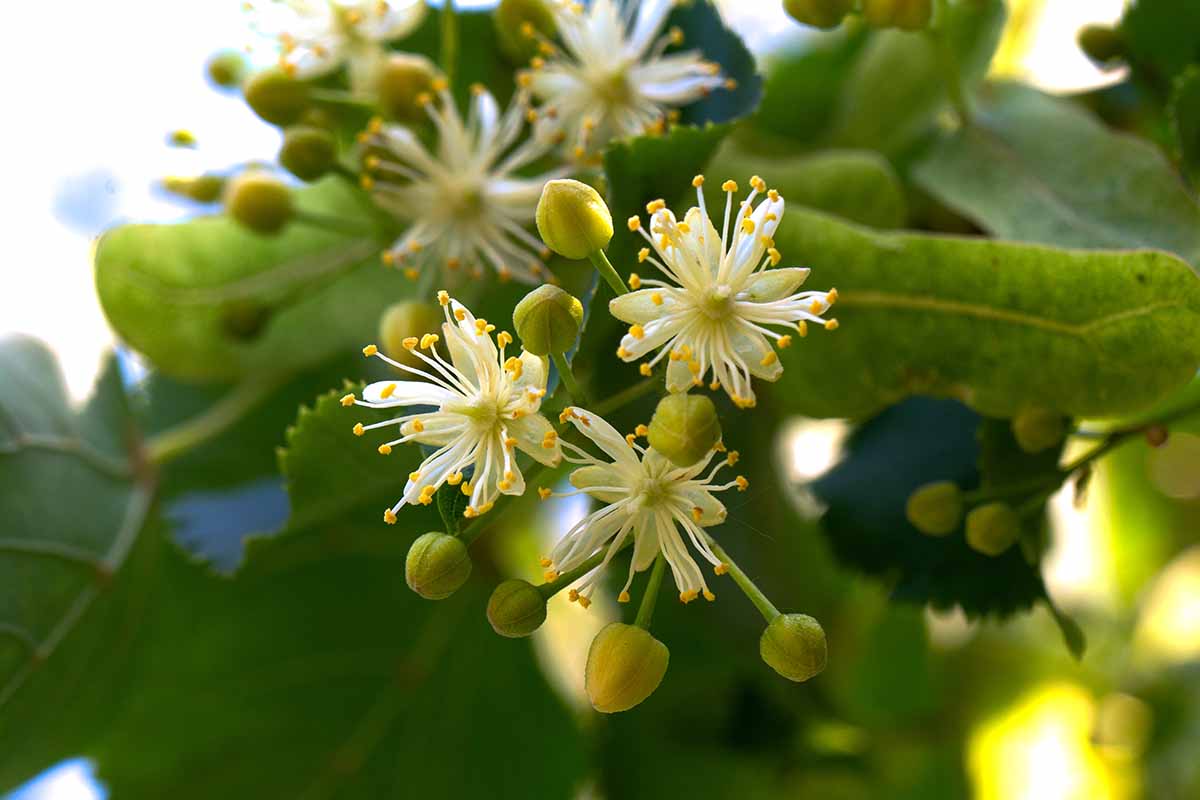
In ideal conditions, and depending on the species, lindens can reach heights of 40 to 100 feet tall with canopies spreading 30 to 60 feet wide.
They grow quickly when they’re young, but then average out to a moderate growth rate. They’ll reach their mature size, or full expression, after 30 to 60 years.
During spring and summer, the importance and value of lindens become front and center in the guild they support, for both humans and other creatures we share our environments with, including pollinators and squirrels.
As spring emerges, lindens begin to show signs of life as they break dormancy. Buds swell and then open, giving way to edible, heart-shaped leaves that unfurl in a fresh, vibrant green hue. Leaves are typically serrated or toothed along their edges.
By late spring, the trees are adorned in fragrant, pale cream or yellow flowers. These flowers are often pendulous, hanging in clusters. The flowers are edible, and they’re also a favorite of bees, drawing them in with their sweet scent and nectar.

Moving through summer, the canopy is dense and full, providing ample shade, and this foliage remains a rich green. Flowers begin to fade, then produce small, round, nut-like fruits.
These fruits are typically attached to a wing-shaped “leaf,” known as a bract or bracteole, that aids in dispersal by the wind when they detach.
The fruits, although not toxic, are not recommended for human consumption. They’re small and hard, and not particularly palatable. But although we might not like the taste of them, birds and squirrels sure do!
The trees continue to be a hub of activity through the seasons, with various insects frequenting the flowers for their nectar, and squirrels collecting seeds. As temperatures drop and days shorten in fall, lindens begin their next transformation.
The once-green leaves take on shades of golden-yellow, offering a warm and festive autumnal display. Fruits mature and drop, scattering around the base or floating off with the wind.
The foliage colors are not as dramatic as some other deciduous trees in fall, but charming with their golden accent.

After shedding the leaves, linden trees reveal a skeletal branch structure and interior during the winter months.
Even in their leafless winter state, linden trees offer visual interest, the striking silhouette picturesque against the backdrop of winter sky or under a blanket of snow.
Some specimens may hold a few odd, dried fruits, adding charming texture to bare branches. And they do make cheerful displays when lit with outdoor lights!
The smooth, grayish bark becomes prominently furrowed or ridged as the trees mature. The strong, upright branches may grow in pyramidal or rounded forms, depending on the species.
These low-maintenance trees are not only revered for their ornamental value, but are tolerant of air pollution, which makes them a preferred choice for urban settings and developments.
Cultivation and History
Lindens are native to Europe and the eastern United States, as well as Asia, which boasts the highest number of different species.
The Tilia genus is ancient, with fossil records dating back 70 million years.

Over time, the genus has evolved and diversified, leading to the 30 or more different species we know today, each with unique characteristics.
Lindens have been a part of history for millennia, with their presence noted in various ancient texts and archaeological sites.
This tree holds a special place in cultures around the world. In some European traditions, the linden was, and still is, considered a sacred tree – often associated with love, fertility, and protection.
Its heart-shaped leaves, hinting to the symbol of love, were carried by those seeking love and romance; and marriage ceremonies were held under the branches of special village linden trees.
In Slavic mythology, the linden was revered as a holy tree, dedicated to Lada, the goddess of love and beauty. It’s also associated with Freya of Germanic lore, as well as Venus, the Roman goddess of love, and Aphrodite of Greek mythology.
The name “linden” is derived from the Old High German word “linta” and the Old English word “linde.” Over time, these terms evolved into the modern English word “linden.”
This tree has a significant connection to renowned Swedish botanist, Carl Linnaeus – it inspired his name.
To explain briefly, many Swedish names like Lindgren or Lindholm are derived from the word linden. As an example, the name Lindholm suggests a connection to a place where linden trees are prominent.
Inspired by the mighty linden that stood on the family farm in Vittaryd, Smaland, Carl Linnaeus’ father chose to adopt the name “Linnaeus.”
However, the cultural significance is not only limited to myths and legends. Its practical applications, such as in the production of honey and use of the wood to construct lightweight wooden objects, have made it a valuable resource.
Although categorized as a hardwood, the basswood is soft, light and pliable, making it easy to work with.
This wood is one of the best kinds for making hand carvings, baskets, and window blinds, and is also used to make musical instruments such as the bodies of guitars. Other applications include veneers, plywood, as well as pulp and fiber products.
The medicinal properties, especially from the flowers, have been recognized in traditional medicine for centuries.
Herbal remedies include treatment for colds, coughs, fever, infections, inflammation, high blood pressure, and headaches. It can also be used as a diuretic and the flowers make a soothing tea known for its mild sedative properties.

Over time, as urbanization has increased, lindens have become a popular choice for city environmental planning and development projects.
With their versatility and aesthetic appeal, species in the Tilia genus give us many reasons to admire, appreciate, and incorporate them into our own gardens and landscape designs.
Let’s take a closer look at how to propagate lindens.
Linden Tree Propagation
Lindens can be propagated from collected or purchased seeds, or from cuttings. You can also buy young saplings from a reputable nursery or greenhouse to transplant into your garden.
From Seed
Like many other nut trees, lindens tend to produce more flowers and seeds in cycles every few years, and not all seeds are viable, which means during a year of low seed production, they could be a challenge to source.
In the wild, the seeds take an extended period of time to germinate due to their tough, impermeable coating. Incredibly, seeds can lie on the ground for five years or more without germinating, while still remaining viable.
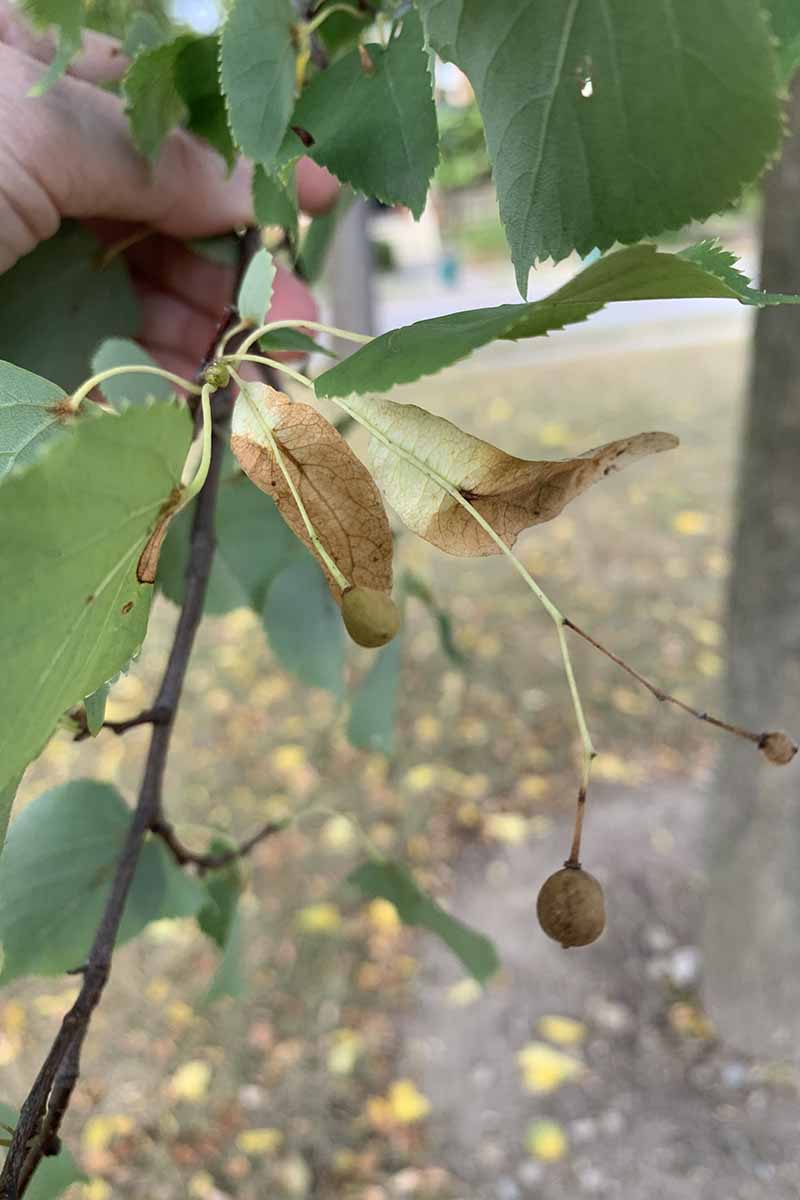
During this time, the seeds must undergo softening from precipitation as well as scarification from damage in order to germinate. This process can take a few years!
You could intentionally speed the process of germination by inducing scarification using sulfuric acid treatment, then following up with a stratification period that takes three to nine months.
Don’t get me wrong, I’m always keen to try new things. But the process required to successfully germinate linden seeds at home is tedious and unreliable. I don’t recommend it.
From Cuttings
Rooting of softwood cuttings offers a more reliable method of propagation. Plus, it will result in a clone of the tree your cutting is from, so you know exactly what you’re getting.
Here’s how to propagate from cuttings:
Plan to take your cutting in late spring or early summer from tender new growth. Young, lateral shoots do better than older or terminal shoots.
Ensure the parent tree is healthy and free of disease. Avoid taking cuttings from specimens that are showing symptoms of nutrient deficiency and stress.
Visual clues indicating stress or deficiency include discolored or wilting foliage, premature leaf drop, a sparse canopy, stunted growth, and pest infestations.
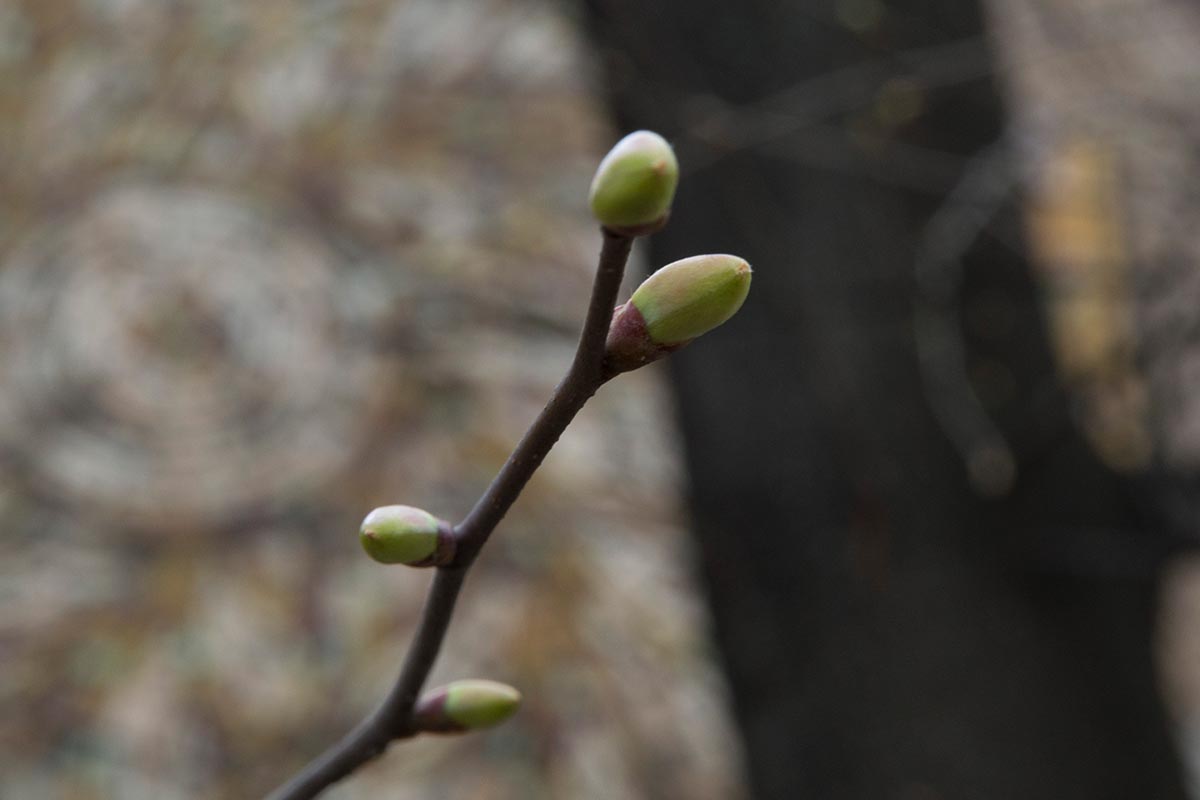
Prepare a tray or other container with sterile, low-fertility, well-draining medium that will retain moisture. Good choices include coarse sand, a mix of peat and perlite, or peat and sand.
Take your cutting early in the morning when the tree is holding the most moisture. Clean a sharp, thin knife or shears with rubbing alcohol to disinfect the blade. Cut a four- to six-inch-long shoot.
Remove the leaves from the lower one-third to one-half of your cutting and treat it with a rooting hormone. Tap off any excess if you’re using a powdered product.
Moisten the potting medium and insert the cutting one-third to one-half of its length into the medium, ensuring the buds are pointed upward.
Space the cuttings a few inches apart to allow all leaves to receive sunlight.
Cover your tray and cuttings with plastic and place them in a warm location with indirect light, avoiding direct sunlight. Keep the medium moist and mist regularly.
The rooting time will take between four to eight weeks. Once rooted, avoid transplanting directly into the ground.
Instead, move your young plants to containers that are at least six to eight inches in diameter to provide ample space for root development.
Wait until they reach at least 12 to 18 inches in height before transplanting out into your landscape.
Transplanting
Whether you’ve grown your own clone from a cutting or purchased a sapling from a nursery, transplanting your young tree is straightforward and easy!
For container-grown specimens, aim to transplant during dormancy. This is either late fall or early spring before bud break. For bare roots, the best time to transplant will depend on your climate.
If you live in the north, bare roots might not survive early freezing in the fall, so aim for spring. But if you live in the south, tender roots could be exposed to too much heat before they are established. In this case, aim to plant bare root saplings in the fall.
Because lindens can grow up 100 feet tall and spread up to 60 feet, they should be spaced accordingly, providing 30 to 60 feet between them and other nearby trees or structures.
If you haven’t conducted a soil test yet, this would be a good time to do it.
If your soil is poor, you’ll want to plan ahead and amend the backfill by mixing in one or two shovels of compost. Do not add fresh manure or chemical fertilizer as this could burn the delicate roots.
When you’re ready, begin by preparing your planting hole. Remove sod and weeds around the area. For container-grown specimens, dig a hole twice as wide and just as deep as the root ball.
For bare roots, your hole should be large enough to accommodate the roots without any restriction.
If you are planting a bare root, pile a little mound of soil in the bottom of the hole and spread the roots gently on top of the mound.
For container-grown trees, remove the tree from its pot, and loosen the roots gently, teasing them apart if they’re tightly bound. Trim any damaged or unhealthy roots.
The root ball should be as deep in the ground as it was in its container.
In the case of bare root trees, ensure all roots are under the level of the ground, with the trunk flare even with the surrounding surface. You may need to adjust the height of your small supporting mound to achieve the ideal level.
Backfill carefully and gradually, gently tamping the soil as you cover the roots. This will remove air pockets around the roots as you work. Tamp the surface, firming around the root system, then water in slowly and thoroughly.
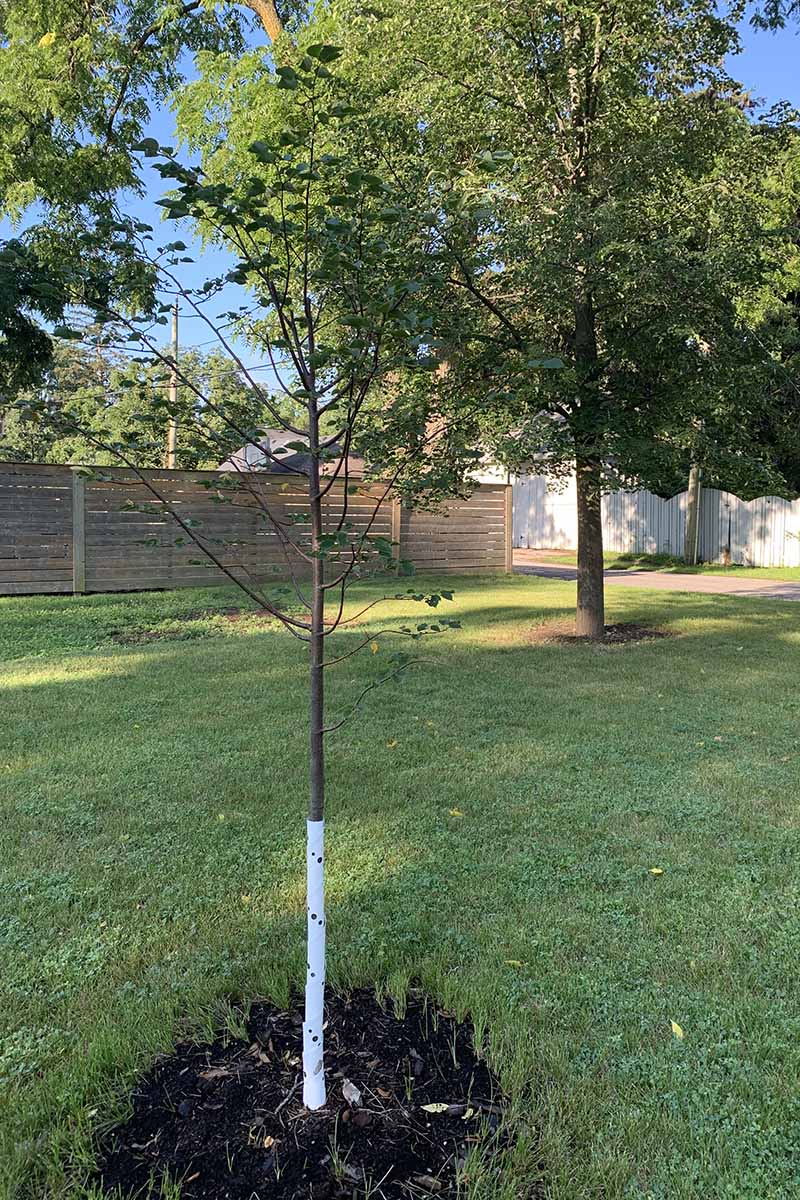
I like to water my new trees in with two successive watering sessions. I give them two or three gallons of water, let it drain, and then repeat. This helps to remove small air pockets from the soil and ensures a deep initial watering.
Spread a two-inch layer of wood chip mulch around the base of your tree, far enough from the trunk to cover the size of the planting hole – or to the drip line whichever is larger.
The drip line is the imaginary line on the ground that matches the circumference of the tree’s canopy above. Avoid piling mulch against the trunk, as this can encourage rot and rodent damage.
Mulch improves the soil as it decomposes and also suppresses weeds while creating a barrier to protect against moisture loss and extreme temperatures.
I always stake my new, young specimens for at least one full year after planting. This keeps them stable as their roots become established, especially in the case of bare root trees.
You can use any long, strong material that will remain stable through inclement weather. Some gardeners use wooden stakes. I prefer to use aluminum line posts like these made by Fortress Building Products, available at Tractor Supply Co.
Pound two or three stakes into the ground one to two feet away from the trunk and secure the tree with soft straps.
The last thing I always do is protect the trunk with a tree wrap.
Herbivores rarely bother lindens, but when they’re hungry, the soft, tender bark of any young tree becomes a delicious feast for rabbits. Trust me, I’ve learned the hard way.

I’ve tried several trunk protector designs, and my favorite is the spiral design like this one made by Goetor, available via Amazon.
The pack of four contains two different sizes, so you can match the best size for your tree.
They are almost spring-like, making it easy to install and remove, and simple to periodically inspect the bark on the trunk. They also expand as the trunk grows.
How to Grow Linden Trees
Linden trees are somewhat forgiving, but as with all plants they thrive best and reach their maximum potential under ideal conditions. Let’s explore a few of their general needs:
They flourish in full sun but will tolerate partial shade, and they prefer moist and well-draining, rich, loamy soils with a neutral pH.

That said, they’re capable of withstanding average soil composition and a slightly acidic to slightly alkaline pH level as well. The recommended pH range is 6.0 to 8.0.
The watering needs of a young tree are different from those of an established specimen. They need more water during the first year or two after planting, and then become less demanding as they mature. Let’s take a look at what that watering looks like.
Newly planted specimens require consistent and thorough watering to establish their root systems, with a general guideline of providing water every two to three days in the absence of rain.
It’s crucial to ensure that the water penetrates deeply into the soil, reaching the entire root ball and surrounding area to promote healthy root growth.
On the other hand, established lindens have more extensive root systems and typically require less frequent watering, with a good soaking every few weeks during dry periods being sufficient.
However, it is important to monitor soil moisture levels and adjust your watering practices accordingly, as established trees can still suffer from drought stress, particularly in extended dry conditions.
If you’re wondering whether or not you should water, try the simple finger test. Stick your finger three inches into the soil around the drip line. If it’s dry, then it’s time to water. If it’s moist, check again in another day or two.
If you’ve acquired a property with an existing linden that doesn’t seem to be thriving, it’s a good idea to test the soil for nutrient levels and pH and adjust accordingly.
A simple NPK soil test kit like the one made by Rapitest, available at Gardener’s Supply Company will help.
They also carry the Rapitest pH test kit at Gardener’s Supply if you’re concerned about the pH level.
You should also inspect moisture levels and drainage and develop a plan to improve these conditions.
What does this mean? If a tree is planted in shade, in poor soil, and adequate moisture is not maintained, it will likely do poorly in comparison to one planted in full sun, rich loamy soil with good drainage, and watered regularly.
In summary, choose the right site, amend poor soil with organic matter, adjust the pH level to improve it if necessary, and irrigate until the tree is established, which could take one to three years.
Growing Tips
- Choose a planting site with full sun.
- Plant in rich, loamy soil that is well-draining.
- Provide consistent moisture especially when trees are young.
- Space new plantings 30 to 60 feet apart, depending on the species.
Pruning and Maintenance
Pruning guidelines for linden trees vary depending on the species you are growing. The best method for pruning depends on your species and its growth habit.
For example, the European linden, T. x europaea, tends to sucker from the base, so it must be pruned regularly to avoid becoming an overgrown mess.
It’s also worth noting that lindens such as the little leaf cultivar ‘Greenspire’ can be pruned and trained to form a dense allee, or tall hedge. This pruning method is called pleaching.
Pruning like this, as well as any other trimming of tall, large mature trees, is usually best left to professionals. You might want to find a good arborist nearby to perform this task!
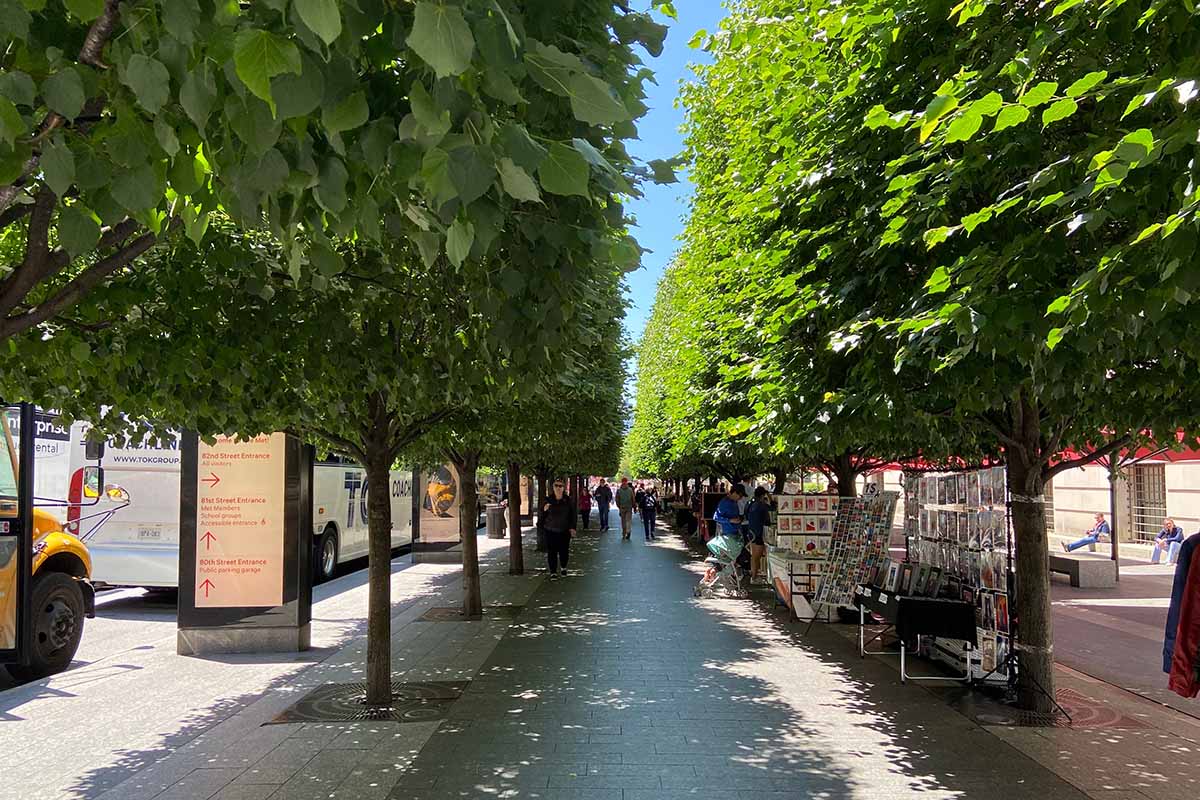
Generally, as with most deciduous trees, pruning should be performed during dormancy. This means it should be done during the coldest months, or at least before the specimen breaks dormancy in early spring.
If there is an immediate need to do so, a few small branches can be removed during the summer after the flowers have faded.
Aim to remove any dead, diseased, crossing, and crowded branches. It’s also beneficial to trim lower branches to facilitate easy movement and maintenance underneath the canopy.
This creates a comfortable space for relaxing in the shade, and simplifies lawn mowing and garden tending tasks, and is best done while the tree is young and developing, by targeting one or two lower branches annually over a period of several years until the optimal clearance is achieved.
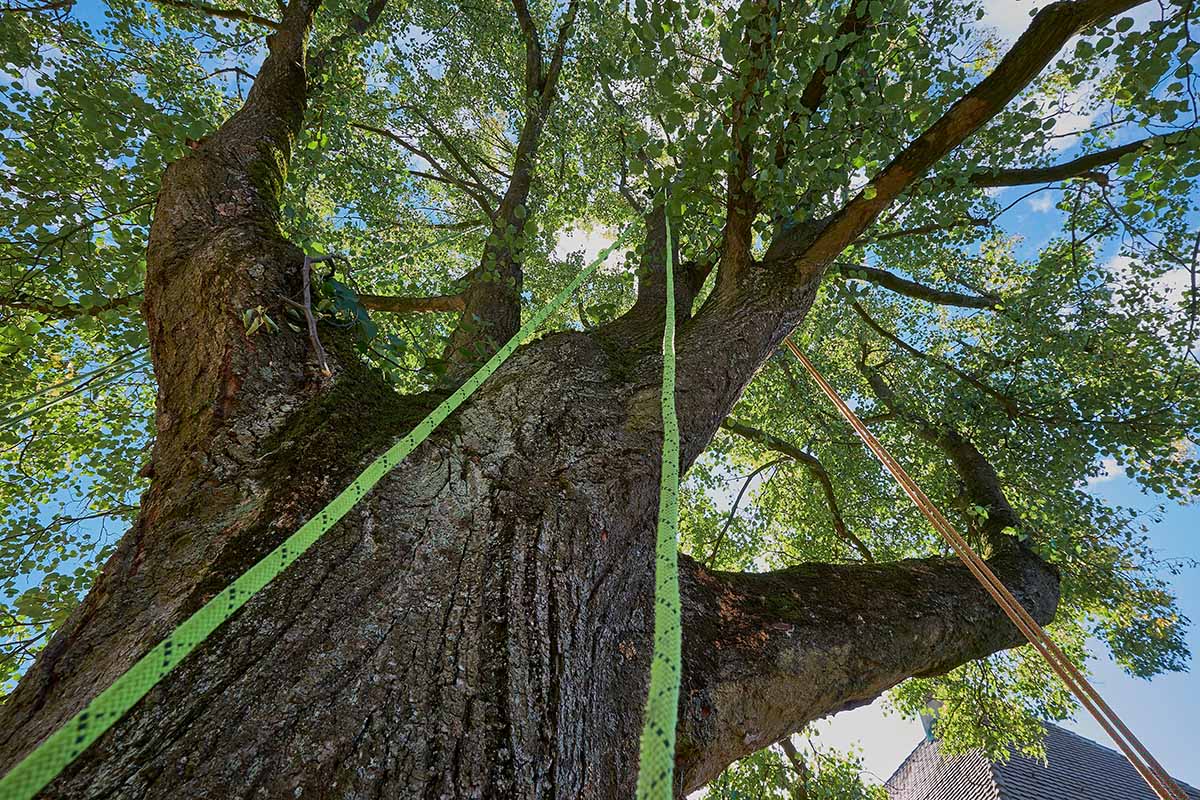
As the tree grows tall, the shape of a mature specimen can be maintained with a regular pruning session by professionals every three to five years.
Spring is the best time to top-up with a fresh layer of mulch. Freshen it up annually to maintain a two- to four-inch-thick layer. Avoid piling mulch against the trunk, be sure to keep it a few inches away.
As your linden matures, its root zone will increase in diameter. To protect the developing roots below the soil, gradually expand the mulched area outward, eliminating grass and following the size of the drip line if possible.
If your space won’t allow for this, aim for at least three feet of width around the base of the trunk.
Many people wonder if they should include fertilization in their regular maintenance routine. Before fertilizing your linden, assess its health. It’s a common misconception that we should fertilize every year.
If your tree is healthy and showing new growth, there is no need to apply fertilizer. If your tree shows signs of poor health or slow growth, test the soil first, then amend with appropriate nutrients accordingly.
The only winter care maintenance tip to implement is when your tree is three years of age or less.
As I mentioned before, bunnies and other critters might see the tender flesh of the trunk as an easy-access snack during the cold months. Protect young trunks with a barrier, especially during the winter.
Linden Species and Cultivars to Select
There are a variety of linden species with unique characteristics and suited to different growing zones.
Whether you’re situated in the cooler northern regions or the warmer southern states, you’ll find options that thrive in your specific climate, ensuring a successful and flourishing addition to your landscape.
American Basswood
T. americana, known as American basswood or American linden, is a common species native to central and eastern North America.
This is a medium to large, pyramidal shaped tree that reaches a maximum height of 50 to 80 feet, with some reaching over 100 feet.
Well-suited for USDA Hardiness Zones 2 to 8, T. americana is one of the most common North American lindens. Great for shade, its leaves are large, dark green on the top surface with silvery undersides.
You can find your own three- to four-foot tall container-grown or four- to five-foot bare root American linden at Nature Hills Nursery.
‘Redmond’ is an award-winning T. americana cultivar, suited for Zones 3 to 8. It reaches a maximum height of 60 feet at maturity.
Pyramidal in shape when young, this cultivar will fill out to a full, upright oval shape at maturity.
Its leaves are a whopping four to eight inches long, and are some of the last to change color in fall. They may fade to a pale green or yellow before falling from the tree.
Fragrant, light yellow flowers emerge in June, in showy, two- to three-inch clusters.
You can find ‘Redmond’ available as a five- to six-foot bare root or in a #3 container at Nature Hills.
‘McSentry’ is a compact T. americana cultivar, topping out at about 45 feet tall at maturity. Also known as American Sentry® linden, this tree is suited for Zones 3 to 8.
This cultivar maintains a uniform, symmetrical shape as it matures and is said to be less attractive to Japanese beetles than the species.
You can find bare roots and trees in #3 containers available at Nature Hills Nursery.
Carolina Basswood
Carolina basswood, T. americana var. caroliniana, is a variety of American basswood that grows natively in South Carolina, Florida, Texas, and north to Oklahoma and Missouri.
This species performs best in USDA Zones 6 to 9. It has a fast growth rate and reaches a maximum height of 100 feet tall.
Carolina basswoods produce leaves up to five inches long and fragrant, yellow-to-white drooping flower clusters.
European Linden
The European linden, T. x europaea, sometimes referred to as common linden or common lime, is a naturally occurring hybrid cross between the large-leaved linden, T. platyphyllos, and the littleleaf linden, T. cordata.
This tree’s canopy exhibits a full, rounded growth pattern into maturity, which is less pyramidal compared to the American linden.
European lindens tend to sucker from the base and will require regular pruning.
This hybrid has slightly better tolerance for urban conditions like air pollution than other species. Thriving in USDA Zones 3 to 9, this tree can reach a mature height of 50 to 90 feet.
Littleleaf Linden
T. cordata, commonly known as the littleleaf linden, is a medium-sized species native to Europe that has been widely planted in the United States.
It has become naturalized in some of the northeastern states. It offers dense shade and maxes out at 50 to 60 feet tall at maturity.
Compared to other linden species, the leaves of littleleaf are – little – usually one to three inches long.
Stem color also differs, with a greenish to brown hue. The canopies of littleleaf specimens tend to be more dense than those of other species in the genus.
This species thrives in USDA Zones 3 to 7.
You can order your own T. cordata from Nature Hills Nursery, as either a three- to four-foot tall container-grown or a five- to six-foot tall bare root specimen.
‘Greenspire’ is the most common littleleaf cultivar sold in the United States. It keeps its symmetrical, pyramidal shape as it matures and maxes out at about 40 to 50 feet tall.
This cultivar does well in urban settings, is tolerant of air pollution, and produces lovely yellowish flowers in spring.
You’ll find T. cordata ‘Greenspire,’ aka ‘PN 6025,’ in two- to three-gallon containers or as five- to six-foot-tall bare root trees at Nature Hills.
Silver Linden
Silver linden, T. tomentosa, is native to Europe and Asia, and also known as European white lime or white lime tree. It typically grows to a maximum height of 50 to 70 feet.
The leaves are distinctive – glossy green on top and silvery-white underneath.
They appear to shimmer thanks to little white hairs on the silver side, and when they flutter in the breeze, the silver and green flash with movement.
This species grows best in Zones 4 to 7.
T. tomentosa ‘Sterling’ grows to about 40 feet tall and 30 feet wide. It boasts dark green leaves with the signature silvery underside and creamy yellow flowers in spring.
You can find ‘Sterling’ available at Nature Hills.
Weeping Silver Linden
T. tomentosa ‘Petriolaris,’ is commonly known as weeping silver or pendant silver linden.
Although it shares the characteristic of white leaf undersides, its branches droop, differentiating it from the silver linden.
This cultivar grows best in USDA Zones 5 to 9 and reaches a height of 75 feet tall.
Managing Pests and Disease
Linden trees are generally tolerant of pests. Rabbits and deer may enjoy nibbling tender bark and shoots, but only when trees are young.
It’s a good idea to protect new plantings with deer fencing and trunk protectors.
Aside from herbivores, certain insects and diseases might affect the health of your linden tree. Let’s take a closer look.
Insects
Linden trees are magnets for insects, but few will do enough damage to severely impact the health of the trees. However insects that puncture or wound plant tissue can leave the trees vulnerable to disease-causing pathogens.
And certain insects, like aphids, can vector pathogens that might infect and damage trees, so it’s important to be aware of these pests and learn about methods of control.
It’s also important to note that because lindens are so attractive to pollinators, especially in the spring when they are in bloom, it’s crucial to consider the negative impact that systemic insecticides might have on these beneficial insect populations.
Some states like Oregon, Connecticut, and Rhode Island have banned the use of insecticides on linden trees for this reason.
Let’s take a look at a few pests that you may come across.
Basswood Lace Bug
Gargaphia tiliae, commonly known as the linden lace bug or basswood lace bug, is specifically associated with these trees.
They feed on all members of the Tilia genus, but have a particular fondness for T. tomentosa. Native to eastern Europe, they have become an increasing challenge in North America in recent years.
Both adults and nymphs use their piercing mouthparts to extract juices from the foliage, which results in tiny chlorotic spots or “stippling” on the leaf surface. Damage may cause leaves to turn yellow or brown.
To manage these pests, you can spray with a strong jet of water from the hose or apply insecticidal soaps and horticultural oils.
Some systemic insecticides are also effective, but if you choose this method take care to read and follow label instructions to avoid any negative impact on pollinators.
Basswood Leaf Miner
The basswood leaf miner, Baliosus nervosus (previously called B. ruber) skeletonizes and damages foliage.
Although it’s been observed to attack birch, elm, oak, and willow, this pest primarily targets the American basswood tree.
Brown, quarter-inch adults overwinter in leaf litter and debris. They emerge in spring to feed on leaves, then lay eggs inside damaged foliage in June.
After hatching, the larvae feed on the foliage. Pupation occurs in the leaf, and adults emerge in August.
When populations grow out of control, an entire tree can become affected, causing leaves of the whole canopy to take on a reddish-brown hue. This might be especially noticeable in mid-to-late August.
Upon close inspection, leaf damage appears as scarifying or surface skeletonizing, leaving behind a fine-textured matrix of leaf veins.
Treatment with insecticides is not an effective control method. Removing and disposing of debris in the vicinity of an affected tree can help to disrupt the life cycle of these pests.
Elm Sawfly
The elm sawfly caterpillar, Cimbex americana, grows more than two inches long, making it one of the largest sawfly caterpillars in North America. The feeding defoliates many deciduous shade trees, including lindens.
Adults are large, deep metallic blue-colored, fly-like insects that emerge in late May to June. Adult sawflies feed on the tender bark of twigs, while the caterpillars feed on foliage.
Fortunately, the eggs and larvae are food for beneficial insects like parasitic wasps and other flies, and shrews and deer mice feed on the prepupae.
In the case of a large infestation, you can use neem oil or a pyrethrin based insecticide according to manufacturer’s instructions.
Eriophyid Mite
Eriophyes tiliae, aka eriophyid mites, cause various types of damage to plant tissue including blistering, distortion, and discoloration. One of the most common hosts is the linden tree.
Affected leaves develop nail galls, which appear as small, raised, nail-like or spiked protrusions on the upper surface.
Galls may be reddish and turn yellow or green in color. The underside of the leaf may reveal concave depressions beneath the galls.
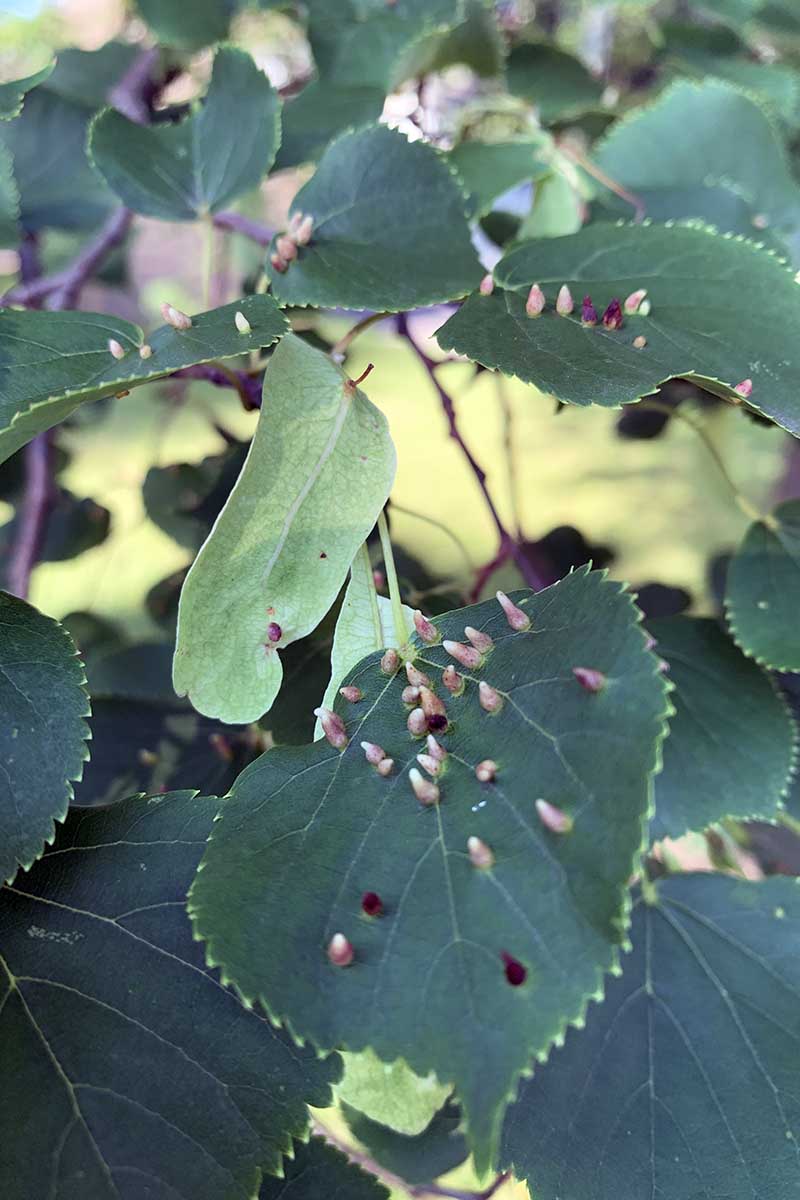
The damage is unsightly but is mostly cosmetic and doesn’t usually pose a severe threat to the health of the tree. No controls are recommended.
Miticides and other insecticides can kill off natural predators, so it’s best to let nature run its course in this case.
European Linden Bark Borer
The linden bark borer moth, Chrysoclista linneella, formerly known as Glyphipterix linneella, is a small, bright orange or yellowish-colored moth with black markings.
The larvae bore into the bark of deciduous trees, particularly the European linden.
As the larvae feed, they excrete rust-colored frass, and a honeycombed appearance is produced in the inner bark. In extreme cases, damaged outer bark can easily be crumbled by hand.
Monitoring for the frass which looks like a reddish, fine sawdust during May and June is key. Native braconid parasitic wasps are known to attack these borers and woodpeckers and sapsuckers will feed on them.
These pests generally target stressed or damaged trees, so maintaining tree health and vigor is a good cultural control strategy, as well as removing and destroying dead and dying trees.
Some chemicals like permethrin and bifenthrin may offer some control, but timing is crucial to disrupt the life cycle successfully without affecting beneficial insect populations.
Japanese Beetle
The Japanese beetle, Popillia japonica, is a scarab beetle easily identified by its metallic green head and thorax and copper-colored outer wing covers. Lindens are one of their favorite food sources.
These beetles are adept fliers and can move in large swarms, easily overtaking gardens and landscapes and leaving massive defoliation and damage in their wake.
When threatened, they often “play dead,” dropping from plants and then sometimes flying away as they fall.
Management of these beetles can be challenging due to their large numbers. Manual removal is effective but can be a challenge with tall trees.
Bait traps are also effective when placed at least 50 feet away from the site requiring protection.
Learn more about battling Japanese beetles in our guide.
Lecanium Scale
Lecanium scale, specifically Parthenolecanium corni, is a pest that targets these trees. They are noticeable in spring when females expand in size.
As they swell, they produce egg masses beneath their bodies and release a significant amount of honeydew which coats nearby foliage.
Females vary in color from red to dark brown and appear as small, oval bumps resembling “helmets” or “turtles” on branches and stems. These pests overwinter on twigs and branches of the host tree.
To manage an out-of-control scale infestation, consider using systemic insecticides such as imidacloprid or dinotefuran, which localize the insecticide within the target plant, reducing the need for external sprays and ensuring the pests are effectively targeted.
Apply the treatment between mid-October and November, or opt for an early treatment in April to May for optimal control.
Alternatively, aim for a more natural approach by controlling scale in their newly hatched nymph stage, otherwise known as “crawlers.”
Monitor their emergence in early summer through visual assessments or by using black electrical tape to catch them, then treat with horticultural oils or insecticidal soaps quickly upon detection.
You can learn more about scale in our guide.
Linden Aphid
The linden aphid, Eucallipterus tiliae, or lime aphid, can be problematic thanks to the large amount of honeydew it produces. The honeydew can lead to the formation of black sooty mold.
During the blooming period, aphid populations can become difficult to control, and it is tempting to use systemic insecticides.
However, this is the time that honeybees are most attracted to the tree, and the insecticide can kill them at the same time.
With several documented cases of mass bumble bee mortality linked to insecticide use to control the linden aphid, caution must be taken to protect bee populations.
Biocontrol efforts, such as the introduction of parasitic wasps, may be an alternative treatment.
Learn more about how to control aphids in our guide.
Linden Looper
The linden looper, Erannis tiliaria, also known as lime looper, is native to the northern United States and parts of Canada.
Typically, populations of these caterpillars stay within normal range but sometimes populations can rise in deciduous trees, causing massive defoliation of trees across multiple states.
Adult female moths lay eggs in clusters under loose bark. These eggs hatch into caterpillars that feed on the foliage for the next month.
Banding trunks in the fall is an effective management method. Pupae live in the soil beneath leaf litter, so regular raking and clean-up beneath affected trees from late summer through fall will also assist during infestations.
Disease
Linden trees are susceptible to a few different diseases. Let’s take a look at the most common ones to watch for and learn the best ways to handle them.
Anthracnose
Anthracnose is a fungal disease caused by Gnomonia tiliae, which manifests as elongated light brown areas along leaf veins, usually near the tips. The spots are bordered by distinct black bands. Severe infections can defoliate the tree.
While some fungicides can prevent anthracnose, their effectiveness is not guaranteed. Once the symptoms are prominent or severe, managing the disease becomes challenging.
Since environmental conditions like excessive rainfall and irrigation can exacerbate this disease, it’s wise to ensure proper spacing between trees and surrounding plants for better air circulation and sunlight exposure.
Leaf Blight
Linden trees are susceptible to the fungus Cercospora microsora which causes circular brown spots with dark borders. When spots become numerous, entire leaves can turn brown and fall from the tree.
Damage is rarely serious enough to warrant the use of fungicides.
Linden Leaf Blotch
Linden leaf blotch, caused by the fungal pathogen Didymosphaeria petrakiana, commonly affects these trees.
Symptoms typically begin in late summer, often starting as small specks that expand into larger blotches on the foliage. These blotches are characterized by dark brown centers with a distinct feathery margin.
This disease rarely becomes severe, but if it does it can lead to complete defoliation of the tree by mid-September. No effective chemical treatments will rid a tree of this fungus.
To manage it, remove and destroy affected fallen leaves. The severity should be reduced the following spring if conditions are dry enough to suppress it.
Powdery Mildew
Powdery mildew is another fungal disease caused by Phyllactinia guttata. It shows up as white to gray powdery spots, blotches, or felt-like mats on the leaves, stems, and buds of infected trees.
Symptoms are often most severe on young leaves and green shoots. It usually does not cause significant harm to the overall health of trees but can alter their appearance, usually in spring or fall. Leaves of lower, shaded branches may become deformed and turn yellow, and even die in severe cases.
To manage powdery mildew, employ proper pruning to improve light penetration and air circulation between branches, but be cautious with your timing as this can stimulate new growth that is more susceptible to mildew.
During the growing season, limit pruning to severely affected branches only, then aim to prune further during dormancy as needed.
Fungicides can be used to treat severe cases and they can be applied early and repeatedly, according to label instructions, on trees with a history of disease.
If your tree has had powdery mildew in previous seasons, you can treat it with a fungicide before symptoms appear, and continue periodical treatment to keep symptoms at bay.
Look for fungicides that contain chlorothalonil, potassium bicarbonate, sulfur, or thiophanate methyl.
Our guide to powdery mildew has more information.
Verticillium Wilt
Verticillium wilt affects a wide range of deciduous trees, including lindens. It’s caused by fungi, primarily Verticillium dahlia and V. albo-atrum, which enter through the roots and grow in the xylem.
Essentially, the pathogens obstruct the tree’s vascular system, specifically the xylem, which is responsible for transporting water and nutrients from the roots to the rest of the plant. This obstruction can lead to a reduced water flow, causing foliage to wilt and potentially die.
It manifests as sudden yellowing, wilting, and death of leaves and branches, often beginning in one section of a tree. Infected trees cannot be cured.
You might be able to extend the life of the specimen by nurturing it with care, pruning out infected branches, and meticulously watering and fertilizing based on soil tests.
But be aware that this disease can spread. For this reason, it might be best to remove and carefully dispose of infected trees.
However, this disease can easily be misdiagnosed by amateurs, so if you suspect an infection it’s wise to consult a professional arborist for an accurate identification before taking drastic action.
Best Uses for Linden Trees
Linden trees are beloved for their ornamental value and for providing shade in gardens and landscape designs.

Weeping forms add a unique aesthetic with their pendulous branching patterns. And as I mentioned earlier in this guide, some varieties can be planted and maintained strategically to form windbreaks.
Lindens have significant importance in some cultures, but this is not limited to symbolism, myths, and legends. Practical uses, such as the production of wooden objects, have established linden wood as a valuable resource.
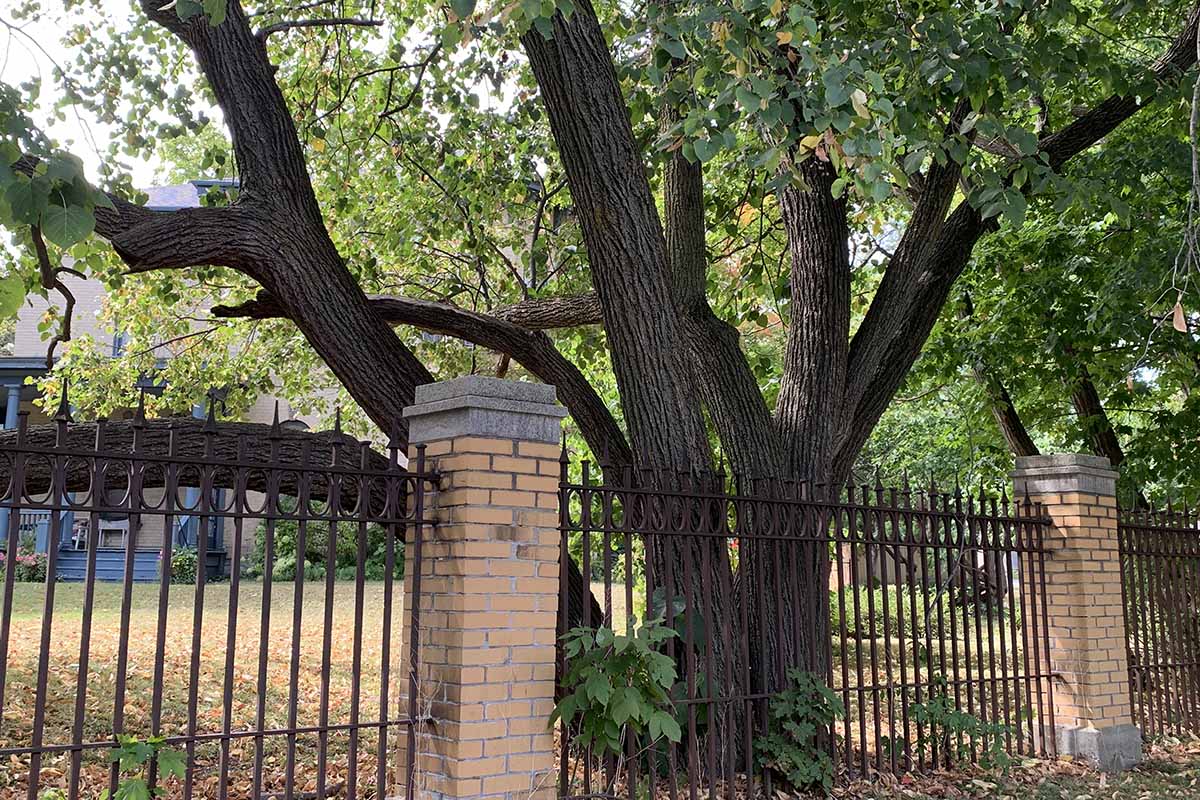
The flowers are a valuable nectar source for honeybees, and the honey produced by bees foraging this nectar is high quality, flavorful, and popular.
It’s fair to say the versatility of these trees is important in both horticulture and practical applications.
Quick Reference Growing Guide
| Plant Type: | Deciduous shade tree | Flower / Foliage Color: | Creamy white to pale yellow; green, yellow in fall |
| Native to: | Asia, Europe, North America | Water Needs: | Moderate |
| Hardiness (USDA Zone): | 2-9 | Maintenance: | Low once established |
| Bloom Time/Season: | Spring, summer | Tolerance: | Air pollution, average soil, slightly alkaline and slightly acidic soils |
| Exposure: | Full sun | Soil Type: | Loamy |
| Time to Maturity: | 30-60 years, depending on species | Soil pH: | 6.0-8.0 |
| Spacing: | 30 feet or more, depending on species | Soil Drainage: | Well-draining |
| Planting Depth: | Depth of root ball (transplants) | Attracts: | Bees, butterflies, hummingbirds, ladybugs; birds, squirrels |
| Height: | 40-100 feet, depending on species | Uses: | Environmental, honey, land reclamation, medicinal, ornamental, shade, woodworking |
| Spread: | 30-60 feet, depending on species | Family: | Malvaceae |
| Growth Rate: | Moderate | Genus: | Tilia |
| Pests & Diseases: | Basswood lace bug, basswood leaf miner, elm sawfly, eriophyid mite, European linden bark borer, Japanese beetle, leucanium scale, linden aphid, linden looper; anthracnose, linden leaf blotch, leaf blight, powdery mildew, verticillium wilt | Species: | Americana, amurensis, cordata, japonica, platyphyllos, tomentosa, x europaea, x euchlora |
Capturing Hearts Everywhere
With their classic beauty, alluring fragrant flowers, and practical functionality, these trees effortlessly capture our hearts. I admire my own linden tree as a symbol of love – love for my family, for my gardens, and for life.
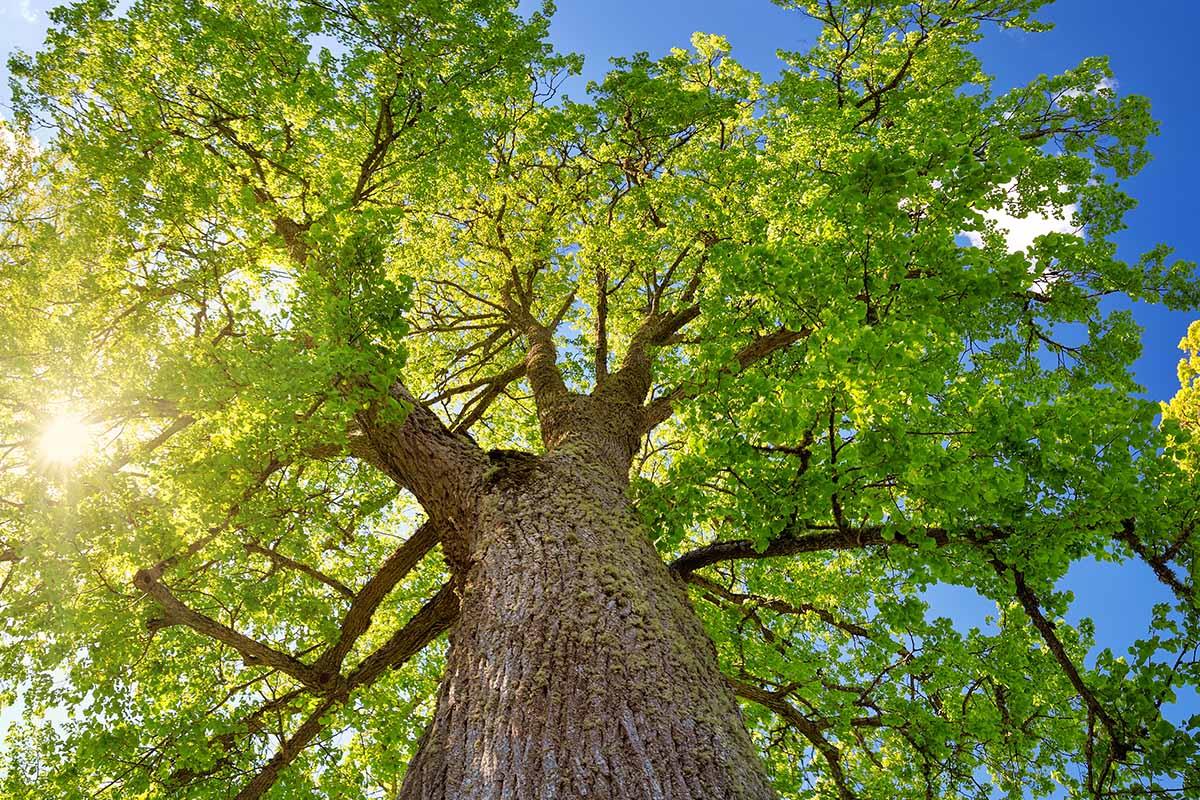
No matter our reason for choosing these trees, it’s clear they’re considered more than just a backdrop in our landscapes. In this guide, we’ve covered everything about planting and growing your own linden tree. The only thing left to decide is where to plant your own!
Does a linden grace your garden already? Which type are you going to plant? Share with us in the comments section below.
And to learn more about other potential trees for your landscape, read these guides next:


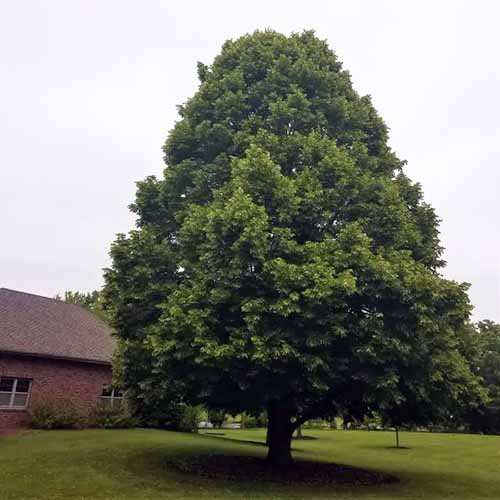
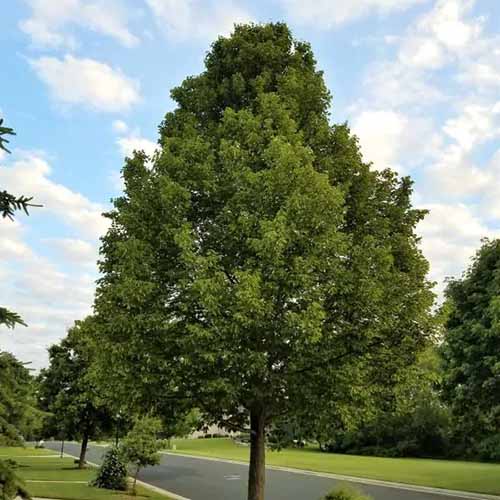
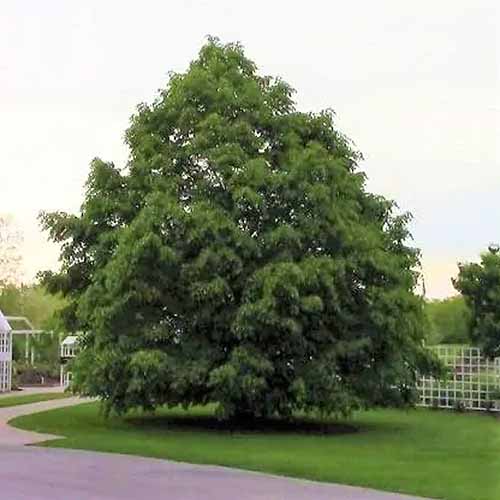
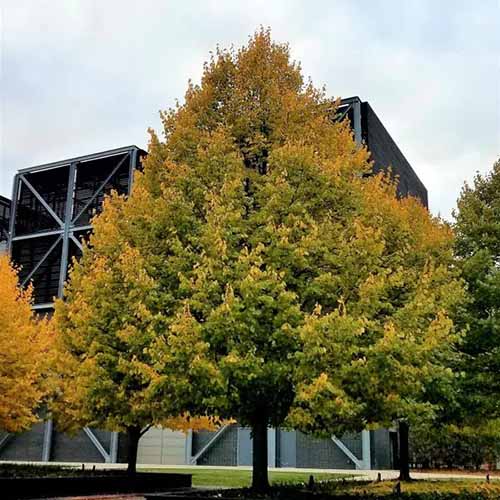
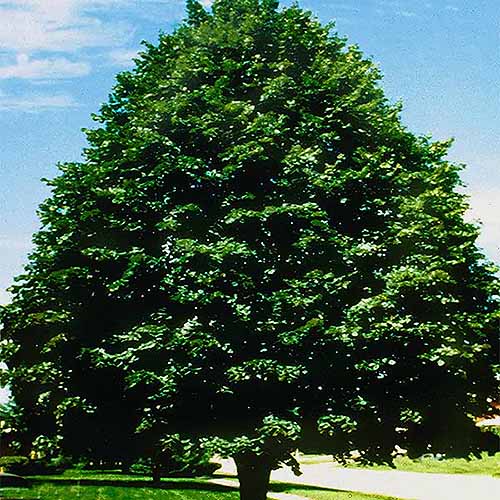
Tomorrow I will be receiving a small silver linden seedling and I still need to order my tree trunk protectors. I already have one silver linden on the other side of the driveway and it’s just beautiful. The soil is loamy and a good pH for linden. Only problem is, the nursery sent the seedling just in time for a heat wave! Wish me luck!
Hi Mila, how exciting! I think so long as you keep the new tree well-watered and possibly consider using some shade cloth if you think it needs a bit of help during the heatwave, it should do just fine!